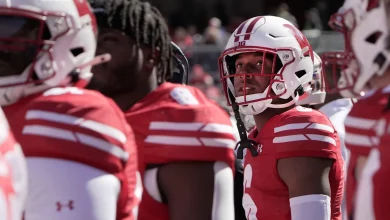Matthew Stafford College Stats: From SEC Liability to SEC Leader, Georgia QB Set the Standard for Future Bulldogs

The evolution of Matthew Stafford’s college football career at the University of Georgia is a fascinating story of growth, perseverance, and transformation. Once labeled as a liability by some critics, Stafford ultimately proved to be one of the most talented and successful quarterbacks in SEC history. Over his three-year tenure as the starting quarterback for the Georgia Bulldogs from 2006 to 2008, Stafford not only erased doubts about his ability but also set the standard for future generations of Bulldogs quarterbacks. His journey from an unproven freshman to the top pick in the NFL Draft serves as a testament to his maturation as a player and his role in elevating Georgia football to new heights.
This article will explore Matthew Stafford’s college career at Georgia, focusing on his stats, the challenges he faced, and how his development influenced the program. His time in Athens laid the foundation for future quarterbacks and demonstrated the potential of the Bulldogs’ offensive system. Stafford’s legacy in college football, particularly in the SEC, is a blueprint for future generations of quarterbacks striving for excellence.
The Arrival of Matthew Stafford at Georgia
Matthew Stafford’s arrival at the University of Georgia was met with high expectations. A highly sought-after recruit out of Highland Park High School in Dallas, Texas, Stafford was ranked as the number one quarterback in his class by several recruiting services. He was a prototypical quarterback prospect, possessing a cannon for an arm and a poised demeanor on the field. Despite his early success in high school, Stafford’s freshman season at Georgia would be one of challenges and adjustments.
When Stafford arrived at Georgia in 2006, the Bulldogs were coming off a 10-3 season under head coach Mark Richt. The team was loaded with talent, but the quarterback position was unsettled. Georgia had just lost DJ Shockley, who had led the team to a SEC Championship in 2005, leaving Stafford with big shoes to fill.
2006: A Rocky Start
Stafford’s first year in Athens was one filled with ups and downs. As a freshman, he was thrust into the starting role early in the season. He showed flashes of brilliance but was inconsistent throughout the year. Over the course of the season, Stafford completed 55.4% of his passes for 1,749 yards, with 7 touchdowns and 13 interceptions. While these statistics may seem lackluster compared to his later years, they reflected the growing pains of a young quarterback learning to navigate the speed and complexity of SEC defenses.
Stafford’s struggles in his freshman year led to questions about whether he was ready to lead Georgia’s offense. His propensity for turnovers, inconsistent accuracy, and lack of experience at the collegiate level made many doubt his ability to live up to his lofty recruitment status. Despite the criticism, Stafford remained resilient. He showed flashes of the talent that would eventually make him the top pick in the NFL Draft, and his performance, though erratic, hinted at his immense potential.
The Bulldogs finished the 2006 season with an 8-4 record, including a disappointing loss in the Sugar Bowl to West Virginia. While Georgia’s offense as a whole struggled, Stafford’s individual growth was evident. The 2006 season served as an essential learning period for the young quarterback, setting the stage for his future success.
2007: The Rise of Stafford
By 2007, Matthew Stafford had a better grasp of Georgia’s offensive system, and the team’s fortunes began to change. Stafford was more mature, more confident, and had a better understanding of the game. Under second-year offensive coordinator Mike Bobo, the Bulldogs’ offense took a step forward, and Stafford’s performance followed suit.
Stafford’s 2007 season was a significant improvement over his freshman year. He threw for 3,499 yards, completing 57.4% of his passes with 25 touchdowns and just 10 interceptions. His completion percentage was higher, his touchdown-to-interception ratio had vastly improved, and his decision-making was sharper. This improvement made Stafford one of the most promising quarterbacks in the nation.
A key moment in 2007 was Georgia’s rivalry game against Florida, where Stafford led the Bulldogs to a 42-30 victory. Stafford threw for 270 yards and 4 touchdowns in a performance that solidified his standing as one of the top quarterbacks in the SEC. His ability to perform under pressure and lead the Bulldogs to crucial wins showed how much he had matured since his freshman year.
The Bulldogs finished the season with an 11-2 record, including a Sugar Bowl victory over Hawaii. Stafford’s performance in the postseason, where he threw for 268 yards and 3 touchdowns in a dominant win, was a testament to his growth as a leader. The 2007 season was a breakthrough year for Stafford, and it set the stage for his final year at Georgia.
2008: Stafford’s Stellar Final Season
Matthew Stafford’s final year at Georgia was nothing short of spectacular. The Bulldogs entered the 2008 season with high expectations, ranked 1st in the nation in some preseason polls. Stafford, now a junior, was firmly entrenched as the team’s leader and one of the top quarterbacks in the country.
Stafford’s 2008 season was one of the best in Georgia football history. He threw for 3,459 yards, completed 61.4% of his passes, and finished with 25 touchdowns and only 10 interceptions. His improved accuracy, combined with his exceptional arm strength and ability to make all the throws, made him one of the most coveted quarterbacks in college football. Stafford had solidified his reputation as a pro-style quarterback who could execute Georgia’s offense with precision.
Throughout the 2008 season, Stafford played with poise and confidence, leading the Bulldogs to several big victories. He had one of his most impressive performances in a win over Auburn, where he threw for 220 yards and 4 touchdowns, helping Georgia secure a dominant victory. Stafford’s ability to make critical throws in clutch moments became a hallmark of his play.
However, the 2008 season wasn’t without its challenges. Georgia finished the regular season with a 10-3 record, and although Stafford played at a high level, the team was unable to meet the lofty expectations set before the season. Despite some setbacks, Stafford’s performance continued to impress scouts and fans alike.
Perhaps the most memorable moment of Stafford’s college career came in the Capital One Bowl against Michigan State, where he threw for 250 yards and 3 touchdowns, leading Georgia to a dominant 24-12 victory. Stafford’s leadership, combined with his ability to perform in big moments, cemented his legacy as one of the greatest quarterbacks in Georgia history.
Legacy and Influence on Georgia Football
Matthew Stafford’s college career set the bar for future Georgia quarterbacks. While the Bulldogs had experienced success before Stafford’s arrival, his time in Athens marked a new era of offensive prowess. Stafford helped define the quarterback position for Georgia, and his statistics, leadership, and resilience influenced a generation of players and recruits.
Stafford’s legacy at Georgia isn’t limited to his individual achievements. He left behind a lasting impact on the program. His ability to handle the pressure of playing for a national championship contender, his work ethic, and his leadership in the locker room served as a blueprint for future quarterbacks at Georgia. In particular, Stafford’s development provided a roadmap for quarterbacks like Aaron Murray and Jake Fromm, who followed in his footsteps and helped maintain Georgia’s status as a perennial contender in the SEC.
Stafford also set a standard for the type of pro-style quarterback that Georgia would recruit in the future. His combination of size, arm strength, and accuracy became the model for the Bulldogs’ recruiting strategy, and Georgia would continue to seek quarterbacks who could operate within the same framework that Stafford helped establish.
The Role of Stafford in the SEC
Stafford’s time in the SEC wasn’t just marked by individual achievement; it also played a key role in elevating the status of the conference. The SEC has long been home to some of the most talented quarterbacks in college football, and Stafford’s play was a significant contribution to the ongoing narrative of the SEC as the premier football conference in the country. He competed with the best, facing off against quarterbacks like Tim Tebow of Florida and Matt Ryan of Boston College, and more importantly, he played in some of the most high-profile games in college football.
Final Thoughts
Matthew Stafford’s college career at the University of Georgia was one of transformation, growth, and ultimately, greatness. From a freshman labeled a liability to an SEC leader and a top NFL draft pick, Stafford’s journey is a testament to his talent, determination, and the coaching that helped shape his development. His time at Georgia set the standard for future quarterbacks, not just for the Bulldogs, but for any quarterback looking to lead a team at the highest level of college football.
Stafford’s college stats are a reminder of his greatness, but perhaps his most lasting legacy is the way he changed the expectations for Georgia quarterbacks. His performance under pressure, his leadership, and his skill set not only elevated Georgia football but helped propel the SEC into the modern era of college football. Stafford left an indelible mark on Georgia, the SEC, and college football, and his legacy continues to be felt by the next generation of quarterbacks who aim to follow in his footsteps.









